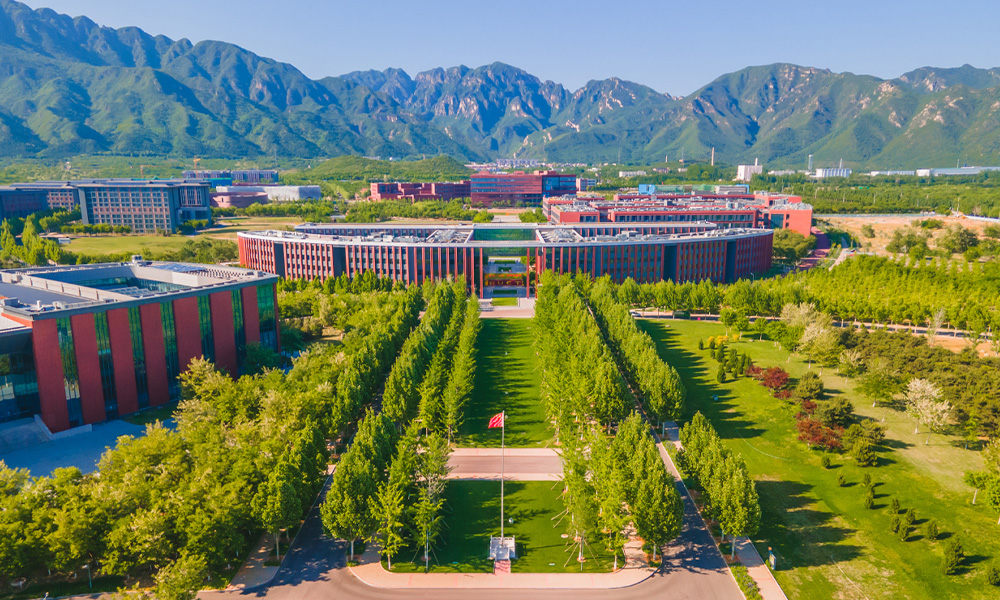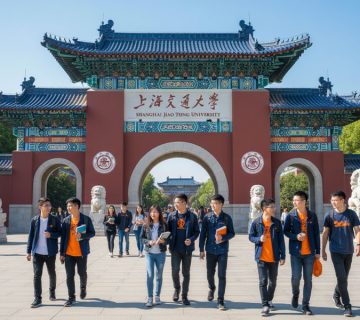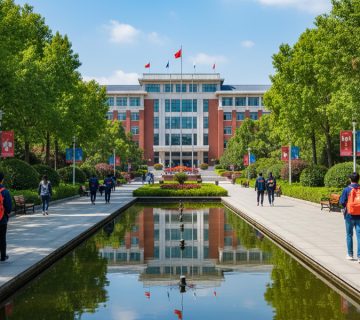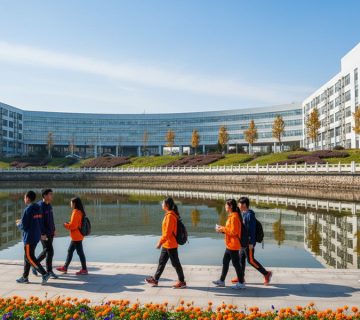Bordered by the curves of the Xiang River in the center of Hunan Province, Changsha beats to a rhythm that is a thousand years old yet exceedingly modern. Provincial capital, it is where skyscrapers over millennium-old schools of scholarship cast long shadows, and spicy stinky tofu stalls crowd streets alongside shiny high-speed rail tracks. For international students seeking a transformational learning experience in 2025, study in Changsha universities is not just cheap; it’s also a dynamic blend of culture and brains.
It boasts over a dozen universities with a legacy going back to Mao Zedong’s days working as a library clerk at Peking University—though his revolutionary fire was ignited elsewhere—Changsha has been a cradle for brains for decades. This article from admission institute delves deep into the significance of Admission requirements for Changsha universities in 2025. We’ll bring to light institutions of interest, enlighten you about tuition fees of Changsha universities, and underscore the benefits that make this gemstone a smart decision.
Why Changsha?
It’s easy: the city boasts the best universities at a fraction of study in Beijing universities or Shanghai’s costs, added to an open environment that’s less scary for the newcomer. Tuition fees of Changsha universities run from about 20,000-30,000 RMB a year for most programs, and living expenses fall below 3,000 RMB per month if you’re clever about campus diners and shared accommodation.
But over the numbers, study in Changsha universities concentrate on education in practical skills in fields including engineering, medicine, and business, complemented by partnerships with world leaders. In 2025, when China elevates its “Double First-Class” project to match the world’s best institutions, higher education in Changsha universities involves access to a network that is reshaping sectors from AI to renewable energy.

Why Study in Changsha Universities?
Changsha is no typical Chinese city—it’s a strategic crossroads were tradition fuels innovation tomorrow. Home to 16 top universities on EduRank’s 2025 rankings, it punches well above its weight in research output, boasting over 454,000 academic publications and 7 million citations under its belt. The city’s universities thrive on the “red soil” culture of Hunan: resilient, resourceful, and community-oriented. For international students, study in Changsha universities translates to courses that blend rigorous study with hands-on practice, often in English, and a cost of living 24% less than in Beijing according to Expatistan statistics.
1. The focus on STEM fields is a major draw.
The Changsha universities are the front-runners when it comes to engineering and technology, a reflection of Hunan’s industrial hub in rail, power, and mining. Take the National University of Defense Technology (NUDT), a PLA behemoth that has emerged as global leaders in supercomputing and cybersecurity. Its alumni spearhead quantum tech, and partnerships with firms like Huawei offer internships that border on apprenticeships. Central South University (CSU) is similarly placed at 491 QS 2026 globally but spearheads materials science—batteries for electric vehicles in the next generation. These aren’t ivory-tower setups; they’re laboratories in which students test prototypes amidst the buzz of the Xiangjiang Innovation Hub. Changsha has more than technology to share, though.
Hunan Normal University (HNU), founded in 1938, shines in education and the humanities, with its Confucius Institutes in Liberia and Montenegro. For the business- or agriculture-bound, Hunan University (HU) and Hunan Agricultural University provide hands-on programs along lush Yuelu Mountain trails—perfect for interspersing study with Saturday hikes. And remember cultural immersion: Changsha’s UNESCO-listed Mawangdui Han tombs are lessons from the texts, while the annual Dragon Boat Festival paints the river in colors of cooperation and tradition.
2. Cost-effectiveness makes it official
From Numbeo (October 2025), the monthly cost of one student here is 5,723 RMB—1,000 RMB for dorms, 1,500 RMB for food, and transportation under 300 RMB. That’s a steal when compared to Shanghai’s 8,000+ RMB minimum. And, naturally, there are plenty of available scholarships: the Chinese Government Scholarship (CSC) covers full tuition for thousands annually, with Changsha unis getting a fair number of them. In 2025, look forward to increased quotas since China plans to welcome 500,000 overseas students by the end of the decade.
Safety is another advantage to study in Changsha universities—Changsha’s crime rate is low, and campuses have 24/7 international offices. For South Asian or African students, the multicultural atmosphere (more than 10,000 foreign student’s province-wide) facilitates the transition, with halal food options and prayer rooms being the norm. Ultimately, university life in Changsha is an investment in a well-rounded launchpad. You’re not earning a degree; you’re learning about a rising global superpower’s language, connections, and way of life—one spicy noodle bowl at a time.

Top Universities in Changsha
Changsha’s higher education scene is a vibrant brocade of top-notch research universities and specialist titans. Let’s get close up and personal with five standouts, each providing unique flavors to 2025 rivals.
| University | Key programs (English Taught) | Undergrad Tuition (RMB/Year) | Master Tuition (RMB/Year) | Dorm Cost (RMB/Month) | 2025 Application deadline |
| CSU | MBBS, Engineering, MBA | 36.000 | 28.000 | 600-1.200 | April 30 |
| HU | Business, Architecture, Economics | 22.000 | 26.000 | 500-1.000 | March 31 |
| NUDT | Cybersecurity, Aerospace | Scholarship Only | Scholarship Only | 800-1.500 | February |
| CSUST | Civil Engineering, Mechanical Design | 18.000-22.000 | 22.000 | 400-900 | April 15 |
| HNU | Education, Chinese language | 20.000 | 24.000 | 500-1.000 | April 20 |
Data updated October 2025
1. Central South University (CSU)
Start with Central South University (CSU) a Ministry of Education darling founded in 2000 from three legacy schools. CSU is considered among the bests to study in Changsha universities. Covering 2.76 million square meters on both sides of Xiangjiang, CSU campuses combine cool labs with serene Yuelu Mountain views. Ranked among ARWU’s global top 100 in mining and mineral engineering, it hosts 58,000 students, of which 2,000 are internationals representing 100+ countries. Strengths? Medicine (its Xiangya Hospital is legendary) and engineering, with English-taught MBBS and MBA courses. Factoid: CSU’s “Initiative 2011” connects academia with industries such as BYD, where grads get jobs at 95% placement rates.
2. Hunan University (HU)
Then comes Hunan University (HU), China’s oldest, dating back to 976 AD, revived in 1903 as Yuelu Academy’s successor. According to University Guru’s 2025 meta-ranking, it’s Changsha’s #1, ranking high in architecture and economics. With 40,000 students, HU’s riverside campus is like a living museum—ancient steles and side-by-side AI labs. Global advantages are dual-degree arrangements with UK and US unis, and its business school ranks top 200 globally by QS. HU’s special strength? A “red genes” heritage—Mao studied here—giving programs their social impact focus.

3. National University of Defense Technology (NUDT)
For geeks, National University of Defense Technology (NUDT) cannot be skipped. Re-founded in 2017 on PLA roots, its Changsha headquarters drives China’s supercomputer leadership (Tianhe series). Accessible only to carefully selected internationals via scholarships, NUDT offers leading cybersecurity and aerospace programs, with state-of-the-art facilities rivaling Silicon Valley. Graduates lead Huawei’s R&D; undergo rigorous training in a demanding but creative setting.
4. Changsha University of Science and Technology (CSUST)
Changsha University of Science and Technology (CSUST) finishes engineering behemoths. Born in 2003 from transport and power colleges, CSUST’s 41,000 students flock to its 16 schools of civil and electrical engineering. ARWU places it 701-800 globally; U.S. News at 514th. CSUST is known as one of the best to study in Changsha universities. English majors in mechanical design shine, with the help of 90+ international partners. CSUST’s crown jewel? Three Confucius Institutes abroad, allowing for cultural exchanges.
5. Hunan Normal University (HNU)
Finally, Hunan Normal University (HNU) is for teachers and artists. It is a key uni to study in Changsha universities under the 211 Project and is optimally ranked in teaching education, with 28,000 students in pedagogy and foreign languages. It welcomes 1,500 foreigners every year to its international college, offering HSK preparation together with liberal arts. Cherry blossoms are sprinkled on its campus, indicating Hunan’s poetic character.
These unis are not silos but are collaborating together via the Changsha National High-Tech Zone, with cross-fertilization. In 2025, expect VR-enabled labs and green campuses as sustainability takes flight.

Admission Requirements for Changsha Universities: Your Gateway to Enrollment
Admission requirements for Changsha universities for 2025 needs planning in advance, but it is facilitated for internationals. Plan ahead—deadlines typically between December to April for September intake. All will need non-Chinese citizenship, good health (through physical examination), and age restrictions: below 30 for undergraduates, 35 for master’s, 40 for PhDs.
Core documents to study in Changsha universities: copy of passport, high school diploma/transcripts (notarized Chinese translation), and study plan (200-500 words for postgraduates). English majors need IELTS 6.0+ or TOEFL 80+; Chinese majors need HSK Level 4-6. Apply online via university websites or CUCAS—fees range from 400-800 RMB.
For CSC scholarships (potential full ride), apply through embassy or agency channel by February. Postgrad apps at CSU require two rec letters and CV; CSUST includes portfolio for design majors. HU places strong emphasis on interviews for business tracks.
Visa-wise, capture JW201/202 form after acceptance to get X1 visa. On arrival, register for residence permit. Tip: Prepare docs electronically—scans make things happen faster. With 85% acceptance for qualified students, persistence is rewarded.
Changsha University Tuition Fees: Value without Price Shock
Tuition fees of Changsha university? Quality without sticker shock. Public unis in at 15,000-30,000 RMB/year for undergrads, 20,000-40,000 for masters—30-50% cheaper than coastal equivalents.
CSU’s English MBBS puts the clock at 36,000 RMB; engineering masters, 28,000. HU’s business undergraduate: 22,000 RMB. CSUST shines at 18,000-22,000 for civil/mech engineering bachelors, 22,000 for masters. NUDT, scholarship-driven, waives for most internationals. HNU’s education courses: 20,000 RMB.
Add-ons: app fee 600 RMB, insurance 800 RMB/year. Provincial scholarships pay 50-100%, for 20% of internationals. Pay by bank transfer; some pay on arrival.
Beyond Tuition: Everyday Life and Living Costs in Changsha
Tuition’s just the starting point to study in Changsha universities—living here’s a bargain at 2,500-4,000 RMB/month. Dorms: 500-1,500 RMB (shared quad to single AC). Off-campus: 1,500-2,500 for a one-bed. Living in Changsha was both affordable and inspiring,” says Maria, a medical student at CSU.
Food? Campus stir-fries: 10-15 RMB/meal; street food like doufunao, 8 RMB. Monthly grocery: 800 RMB. Transport: metro/bus 2-3 RMB/ride; bikes through Mobike, 1 RMB/hour. Utilities/internet: 200 RMB.
Leisure adds spice—KTV nights 50 RMB, Orange Isle Park entry free. Total first-year spend: 40,000-60,000 RMB without tuition. Budget apps like Alipay help track yuan.

Navigating Life: Tips, Culture, and Career Horizons
Changsha university life? Shocking. Participate in dragon boat societies or HNU choir society; explore Yuelu for hanfu photoshoots. Good health services exist—CSU clinic does free checkups. Placement-wise, 90% rate with the help of fairs and WeChat groups. Engineering students get Tencent placements; MBBS students get international hospital placements. Post-graduation work visas ease the transition.
Conclusion
As 2025 arrives, Changsha invites with open arms and affordable vistas. From CSU’s cutting-edge labs to HU’s venerable halls, study in Changsha universities award credentials that resonate world-wide—affordably. At less than 30,000 RMB for tuition fees of Changsha universities, reasonable living costs of 3,000 per month, and a city burning with Hunanese fire, it’s a launch pad for dreamers bold enough to seize it.
Whether chasing circuits or culture, Changsha doesn’t instruct; it sparks. Bring your curiosity—the Xiang brethren await. Indulge in spicy street food, historic Yuelu trails, and a lively expat community that feels like home. Changsha doesn’t provide a degree—it ignites life-long connections, talents, and experiences. Your future begins here, along the Xiang River. For additional information and consultation, contact us.
FAQS:
1. What are the key admission requirements for study in Changsha universities in 2025?
Foreign applicants need to provide their valid passport, high school diploma (notarized Chinese translation), and proof of English proficiency (IELTS 6.0+ or TOEFL 80+) for English programs and HSK Level 4-6 for Chinese-taught ones. A study plan, two letters of recommendation (for postgrads), and application through university websites or CUCAS by April are also applied. There are CSC scholarships and an embassy track by February. Undergraduate applicants shouldn’t be above 30 years of age.
2. How expensive are tuition fees of Changsha universities?
15,000-30,000 RMB/year for undergrads, 20,000-40,000 RMB for masters—30-50% less than Beijing. Examples: CSU MBBS at 36,000 RMB, HU business at 22,000 RMB, CSUST engineering at 18,000-22,000 RMB. Plus 600 RMB application fee and 800 RMB insurance. 50-100% of provincial scholarships for many internationals.
3. What is the total cost of living as a student in Changsha?
Expect 2,500-4,000 RMB/month: dorms 500-1,500 RMB, meals 800-1,500 RMB, transport 200-300 RMB, and utilities 200 RMB. First-year total (excluding tuition): 40,000-60,000 RMB. It’s 24% less than Beijing, with campus cafeterias and Mobike hiring keeping expenses in check.





No comment